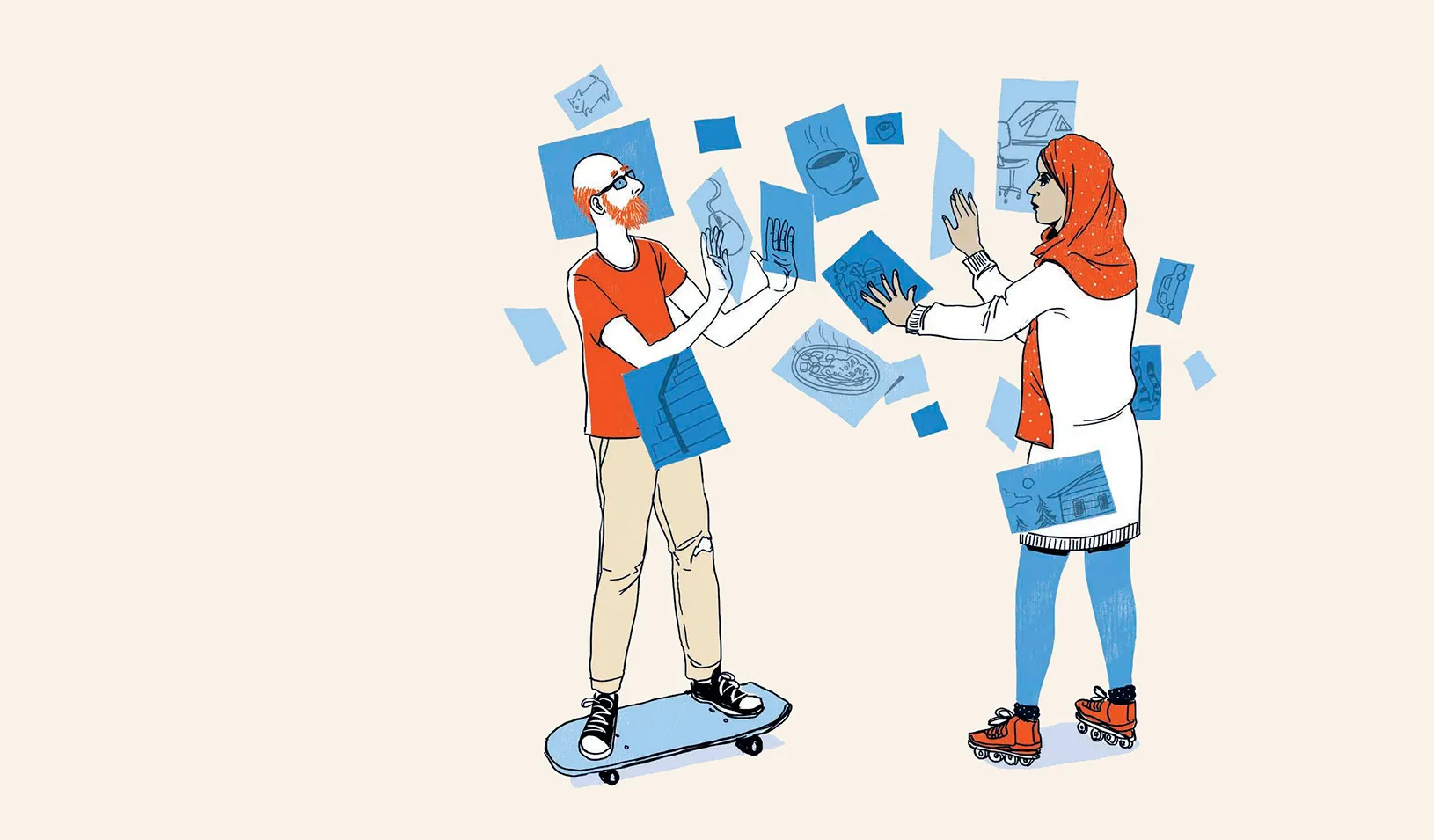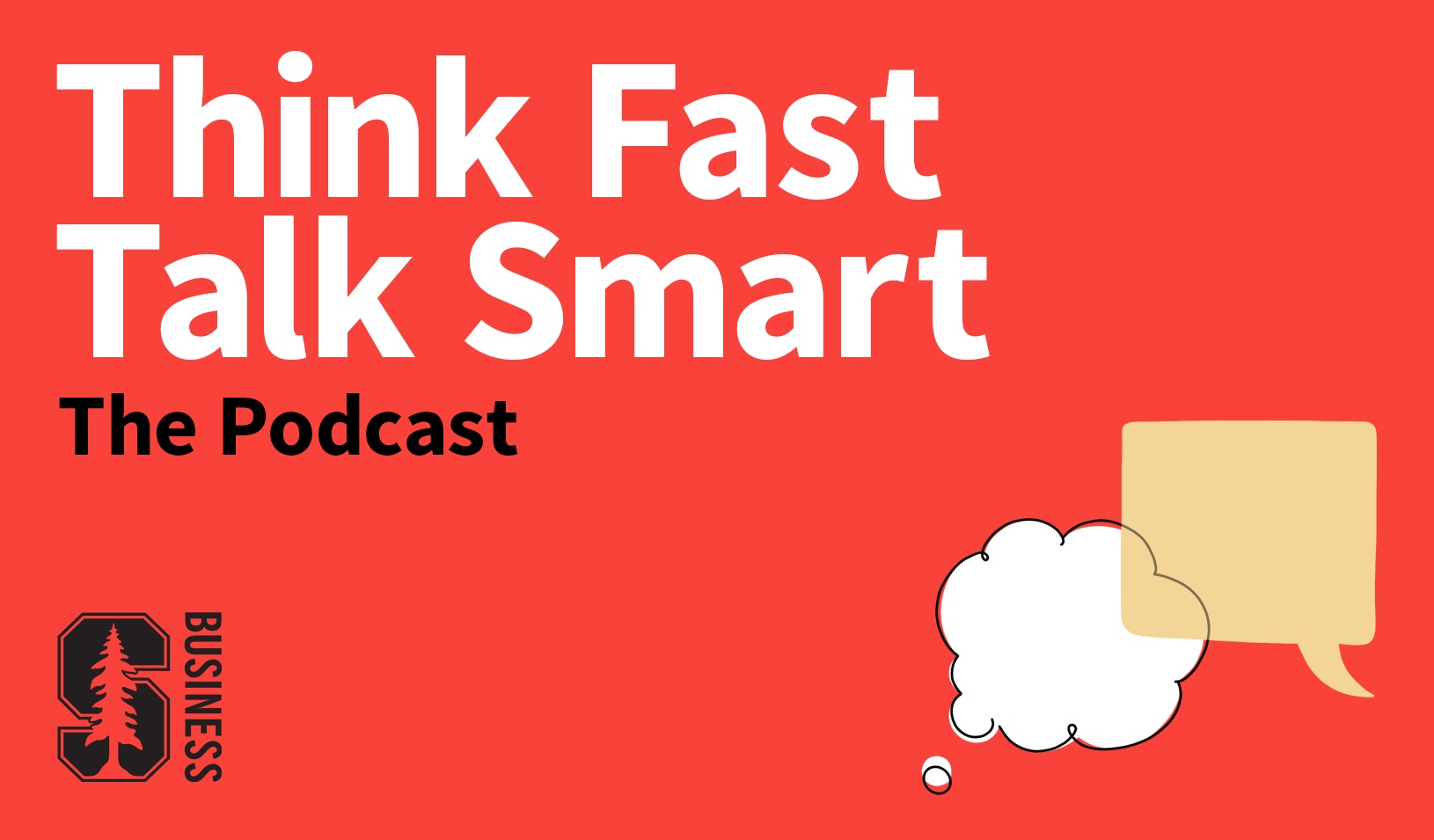Got a Problem? Think Like a Designer.
“Creative Acts for Curious People” makes the Stanford d.school’s approach to problem-solving accessible to anyone.
September 21, 2021

If you think design is only for creatives who pump out slick-looking products, prepare to be surprised. | Illustration by Michael Hirshon
Sarah Stein Greenberg won’t be disappointed if you don’t approach Creative Acts for Curious People: How to Think, Create, and Lead in Unconventional Ways like a typical how-to guide. “There’s no one right way to use this book,” says Stein Greenberg, MBA ’06, the executive director of the Hasso Plattner Institute of Design, also known as the Stanford d.school. “You do not have to read it front to back.”
Loaded with more than 80 creative exercises, the book is a fun and engaging introduction to the d.school’s guiding philosophy. Flip to almost any page and you’ll find an activity or anecdote designed to change how you approach personal and professional challenges.
Looking for a playful way to encourage serious collaboration? Check out “The Secret Handshake.” Want to peel away reluctance to expressing your point of view? Take “The Banana Challenge.” Need to get better at building a culture of constructive feedback? Try “I Like, I Wish.”
And if you think design is only for aloof creatives who pump out slick-looking products, prepare to be pleasantly surprised. Here, the product is solutions and the process is accessible to anyone.
“I think about design as this incredibly flexible set of methods that help you both solve problems and also frame problems in unconventional and creative ways,” Stein Greenberg says. And she stresses that it’s not just for people who think of themselves as designers: “You can come from any discipline, whether it’s business or medicine or engineering.”
The approach emphasizes collaboration, iteration, and humility. It also requires designers to openly question the problem they’re trying to solve and who they’re solving it for. That principle is built into Design for Extreme Affordability, a multidisciplinary course Stein Greenberg has co-taught with colleagues in business, engineering, and design. “Empathy can help connect you to other people’s needs and make sure that you’re not designing for yourself or just your own small team, but actually connecting with something that’s broader and more meaningful,” she says.
Creative Acts for Curious People is the first in a series of guides being published by the d.school over the next couple of years. Stein Greenberg spoke with Stanford Business about its lessons for people seeking creative solutions to challenges big and small.
You write that you dislike small talk. Do you have an opening question you like to use to get beyond the usual chat about weather or sports?
I don’t have a stock question because I feel like there’s no one right question to ask. In the book, I put in my favorite warm-up sequence, “The Story of Your Name.” That’s not totally appropriate for a random cocktail party situation, but it is actually a great way to disarm folks in a more professional context, where that’s not a question you get asked every day. It’s not too personal, but it can open that door to more vulnerability and openness. And I find that’s just so helpful if you’re trying to set the stage for some kind of creative work.
Even a routine interaction can be designed in a really meaningful way. And I do think that’s something special about folks in design. We are fascinated by the big picture and the vision we’re trying to effect with our work, but also those small details. And just the way you introduce someone can be a platform to be more creative or to open the door to something.
A lot of people think of creativity as a solitary pursuit where inspiration is like a bolt out of the blue. Much of your book is focused on collaboration and intention. That might seem counterintuitive, especially for people who feel like they’re not very creative.
We have a lot of mythology in our culture about who is creative and what creativity looks like. I’m on a quest to replace the visual icon of creativity — it can’t be a lightning bolt and it can’t be a light bulb, because they perpetuate that myth that it’s something that happens out of the blue.
At the d.school we do a lot of what we call “setting the conditions for creativity to emerge.” One thing I’ve learned is that that’s where people should be focusing more of their efforts. It’s about showing up to the moment with the trust in place, with the materials in place, with the framing of the problem in place. And that’s actually what allows you to make meaningful progress in a creative way.
You just need a little bit of creative prompting and structure and then you often can do way more creative work than you thought you were able to do. In this book I’m trying to pull those structures out and share them and make them transparent. They don’t have to be a surprise. They don’t have to be hidden. There are tools that everyone can learn how to work with.
Another big idea in the book is being comfortable with ambiguity. Why is that important?
Do we have several more hours? This is a critical topic. Part of the reason that I wrote the book is because we are in this moment where there’s so much uncertainty and so much ambiguity. I’ve seen over and over that through learning and practicing design, people can become better at navigating ambiguity, because every single design project that you’re working on is open-ended and doesn’t have one right answer.
Design gives you the skills and the confidence to feel like, I know how to show up when I’m thrown a problem that I don’t know much about. I have a way to lean into that. I have a way to learn rapidly about the context and about the people, and then to try some small experiments and test some prototypes to see if I’m headed in the right direction.
Do you think the uncertainty of the past year and a half has been useful from a creativity standpoint?
I think that the kinds of changes that we’ve all had to adjust to have had a profound effect. One was showing us how quickly and profoundly our organizations can change. Very rapidly, very large organizations had to change a lot about how they worked. And so, while very uncomfortable and too fast and not equitable, that shift does say something about our capacity for change.
It also foregrounded the need for designing for connection when we’re all distributed. How do we think about employee retention when people have a wide array of things going on, literally in the background? All of a sudden that’s much more visible to managers and leaders. Some of the things I’m cautiously hopeful about is that by going through this experience as a society, perhaps in some cases, we are seeing more empathetic leadership, more focus on the employee experience. I hope that is something that continues.
Designing with other people in mind is another key principle in your book. How is that built into Design for Extreme Affordability?
That class is very important to my own personal experience. I was a student in one of the very early iterations of that course, then led by Stanford GSB Professor Jim Patell. Our partner organization, which is now called Proximity Designs, is based in Myanmar. They were trying to figure out how to help small-plot farmers irrigate their fields. These are people who have very little extra cash; they’re not able to buy a big generator or a diesel-powered pump. The organization had a model of a treadle pump — it looks a little bit like a StairMaster. My team was looking at how could we take some of the costs and expense out of this product by redesigning the frame around it.
My team had a couple of MBAs and a couple of engineers. None of us were farmers. We didn’t have that context; our needs were not the needs that were being served in the project. So it was incredibly important to really deeply connect with the partner. Once we had an initial idea, it went right back to the farmers. They gave us lots of feedback. They told us all the things that were terrible about it and needed to be improved. Working closely in collaboration with the folks in the workshop within Proximity Designs really helped bring that product to its more completed form.
The big takeaway that’s woven into all of the projects in that course is the idea that it’s not just that one time you’re seeking a little bit of input. It’s a much more embedded and collaborative process with the people who have those needs to make sure that you’re refining the idea along the way together.
Many people feel helpless in the face of global and societal problems. Can design thinking help them take action?
Often, when we are confronted with those enormous problems, it’s like, how do you find a way to start? What are the places we can demonstrate a little bit of efficacy or change that helps people start to believe that bigger change is possible?
One of the stories in the book is about a set of d.school alums who work in Detroit. They run a social impact design firm called Civilla. They started working on this extremely ambitious project with the state of Michigan around redesigning the public benefits system. When they started, the form that people applying for benefits had to fill out was the longest in the nation — it was 45 pages. One of the methods the team invented (and it’s included in Creative Acts for Curious People) is called “The Hundred-Foot Journey Map.” They mapped out the entire process, both from the perspective of the person who’s applying for benefits and from the perspective of the caseworker. They found all these points of connection where this interaction wasn’t working for either party.
Breaking up a huge problem into smaller pieces, surfacing the human layer, the empathetic layer, helps you come at those big systems-level problems with a completely fresh mindset. It allows you to see, I can’t change the whole thing tomorrow, but I know how to get started.
For media inquiries, visit the Newsroom.
Explore More

An Invitation for Innovation: Why Creativity Is Found, Not Forced

To Discover Breakthrough Ideas, Look to the Outsiders



